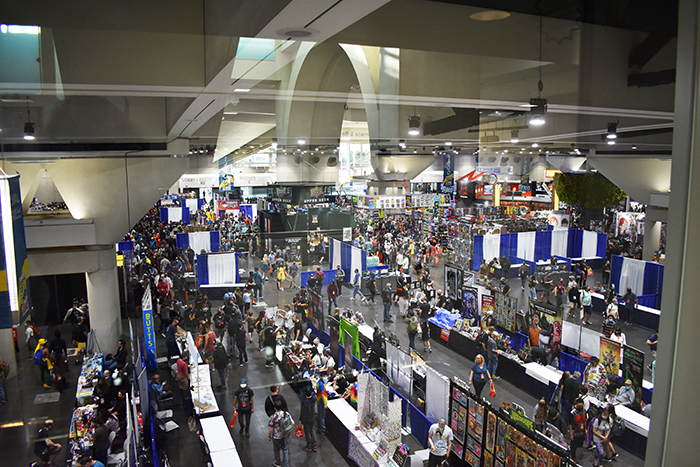
By Shor M. Masori

SAN DIEGO — Comic-Con@Home once again took place online this past summer due to Covid fears. However, Comic-Con also hosted a live convention in San Diego this year, perplexingly on Thanksgiving weekend. So, I took my tryptophan-laden self, picked up my recently Black Friday bruised wallet, and headed downtown to see an all new and all different Con, one from 30 years ago.
Cramming 140,000 eager and sweaty nerds into the convention center at once was an idea that excited no one, so instead they kept the population sparse. 60,000 people were able to buy tickets to Comic-Con Special Edition with the incentive that buying this ticket would ensure their place at the front of the online ticketing line the next time a proper SDCC was held. Anywhere else 60,000 people would make me feel like I’m in a can of sardines but today it felt like I had space to hummingbird around to all of the interesting booths.
As I walked off the bridge crossing Harbor Drive, I saw the familiar site of a wound-up line next to the San Diego Convention Center. Normally that line is reserved for those waiting for entrance into Hall H, the biggest panel room. Instead, this was a line that all those attending had to go through to show proof that they were Coronavirus free. Hall H itself was converted into the registration area, allowing all attendees, press, and professionals to get their program books, a special pin, and a small bottle of hand sanitizer.
The first thing I noticed once inside was how different the layout of the Exhibit Hall was. Each booth aisle had more space. Some creators were able to co-opt the free tables next to them as a staging and break area. There was an entire section set aside so that attendees could take pictures with various nerdy wallpapers. I actually felt like I could go to Cafe Express and buy an overpriced burger in less than an hour!
The panels also had a different vibe. Summer is the time that many trailers are shown for the biggest movies of the next year. This time DC had already announced its line-up at the DC Fandome event and Disney already had itsD-23 Expo. For the first time that I can remember, none of the major production companies premiered something during the Con. The only traditionally ‘big’ celebrity name that I recognized was Brent Spiner, who played Data on Star Trek: The Next Generation and Star Trek: Picard. His panel was the only one that I went to that I couldn’t just walk into after it had started. Even co-creator of the Teenage Mutant Ninja Turtles Kevin Eastman’s panel had seats to spare. Ballroom 20, the second biggest panel location, was only being used for the annual masquerade costume contest. This freed me up to explore more of the Convention Center itself and watch some of the smaller talks.
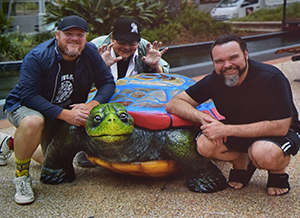
Eastman’s “spotlight” panel provided an inside look into the creation of the Teenage Mutant Ninja Turtles. Eastman and co-creator Peter Laird made TMNT after Eastman drew what he described as ‘the stupidest thing I could think of.’ That was Bruce Lee as the worst animal for fighting: a turtle. After laughing their butts off, Eastman and Laird decided to make the first TMNT comic and the rest is an almost 40-year history. Their company, Mirage Studios, was so named because in reality they were working out of their living room, the company was but a mirage. The first few issues Eastman drew of New York City were completely reference-based as he had never been to the Big Apple. Many comic book covers were inspired by the album covers of Eastman’s favorite bands such as the Beatles and Rolling Stones.
Eastman’s newest comic is currently the best-selling comic in the nation: “The Last Ronin.” Michelangelo is the only turtle left 30 years into a much grittier future. While the idea was originally written in 1987 (set for 2017) it was only after the #100th issue of Teenage Mutant Ninja Turtles came out in 2019 that they started to turn it into a story. “The Last Ronin” is based on the original Mirage Studios version of the Turtles, so old fans may feel reminiscent while new fans may have some catching up to do, at least if they want to get all the references.
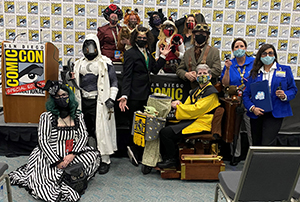
Steampunk Variants across the Pop Culture Divide taught listeners how to cosplay, or create their own costumes, in a steampunk style. If you want to make a costume look more Steampunk, or as if the Victorian Era never ended, here are some easy tips: Goggles are a cliche but work in any costume as they can be worn in a variety of ways. Wearing a corset, regardless of whether it is underneath or on top of one’s blouse in addition to a hat, especially a top hat, will get you a good silhouette. For added flair try adding a fancy belt, fans or umbrellas, buckles, a vest, tailcoats or a monocle. The key to cosplaying is to make it yours, even if that means stealing from everyone around you. Chances are someone has drawn a version of the costume you’re making in a steampunk fashion. If not, there are plenty of other references of steampunk garb and to inspire you.
The last panel I attended was “Developing Global Myth from the Muslim World: A Richer Stroytelling Landscape for Us All” moderator Ausma Zahanat Khan said that the majority of Islamic stories are a celebratory embrace of truth and beauty. This is mainly done not by teaching people how to pray or when to fast, but by showing a true representation of what it means to be Muslim. Unfortunately, actualizing the truth is quite difficult with gatekeepers stopping one’s story from being told.
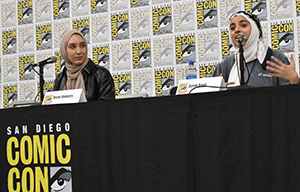
Panelist Sarah Rand enjoys writing contemporary works inspired by her adoration of anime and martial arts. She complained that in most forms of media there is no real representation of Muslims who are comfortable with their religion. Fictional Muslims don’t talk about their faith nor are they shown praying five times a day. A similar truism is found among most Jews in the media. If they aren’t Chasidim in suits, then the Jew is irreligious.
Faith is often not talked about in works of fiction but as Rand points out it’s a major driver in many people’s decision making because it represents their core values. Many in the industry in the positions of publishers, editors, and agents feel as though a truly Islamic tale would be off putting for many readers and hard to market, so they try to steer their talent away from Islamic aspects.
The other panelist, Ream Shukalry, says that to combat this she puts Islamic values in the themes of the story rather than at the forefront. Not unlike how Jerry Siegel and Joe Shushter wove Jewish DNA around Superman, essentially basing his origin story off of Moses, without explicitly making Superman Jewish. As a Syrian-American she’s found that her Syrian cuisine is a great way to get people to respond well to Islamic culture. Four years ago, when Rand was starting her life as a professional writer, she had a big agent reach out to her. He liked her work but thought the book was too cultural and had too many brown characters so he asked her to tone it down. Instead, she found a different agent who not only supported her expression, but embraced it.
Unfortunately, agents as good as that one are hard to come by, so moderator Khan is working on a solution. His company, Fictional Frontiers, will launch next May. It will be a Muslim Creative Collective with networks in many kinds of media. Fictional Frontiers will launch with two stories, Noor Yusuf’s Beyond the Forest as well as Ink and Hack’s Modal.
Beyond the Forest is a Narnia-esk story in which the three protagonists travel through the Legendarium of the Awilya, or sages. The Legendarium takes them through time to learn about the lives and lesson of the Awilya. Modal takes place in a future micromanaged by data. Data collection has gotten so good that it is predicting the future, based on the Muslim understanding of destiny, of course. In Islam, Allah has already written down all of what will happen in the Preserved Tablet (al-lawh al-mahfooz.) This does not mean that humans have no free will, just that Allah has already seen all that will happen. Check out these stories and more next year, only on Fictional Frontiers.
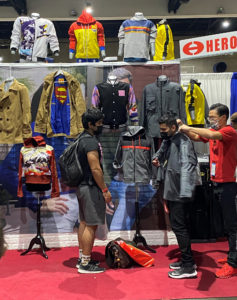
Quality Merch: With Hanukkah starting as the convention ended, I had the perfect opportunity to do some last-minute shopping. If you’re shopping for a nerd some of their online stores may benefit you as well. For a kid that likes the finer things in life, Heroes Within sells hand-designed, high-quality clothing inspired by pop culture but not taken over by it.
As a Clark Kent-inspired reporter, I got a tan peacoat, like the ones reporters supposedly wore throughout the 20th century. Aside from stitching that looks like Superman’s emblem and the inscription “Truth, Justice, and a Better Tomorrow,” it has the appearance of a normal peacoat.
The inside has a blue lining with a bright red and yellow Superman logo in the middle with as many pockets as you can ask for. They really like pockets.
I got my brother Sky a tech jacket that was Batman Beyond-inspired. His logo was found in the back stitching and on the center within the grey coat’s red lining. It had pockets in every place imaginable, I think Sky will love it. Check them out at https://herowithinstore.com/ I got my Grandpa, a magnetic Star Trek the Next Generation badge and matching lapel. For my cousin Danielle, I found some Egyptian-inspired ear cufflink. Finally, I went to Toynk’s booth and got a Black Panther necklace. I don’t know who to give it to yet but it’s always good to get a spare gift. This and many more pieces of pop culture apparel can be found at Toynk.com
Loki: Normally my editor prefers me not to wear a costume, given that I’m working and need to look like a professional nerd. However, this year we were able to meet each other half way. I dressed up as President Loki from the new Loki series on Disney+. The costume is essentially a 3-piece suit with green and gold elements, a Vote Loki! Pin, and a horned crown. Having a lowkey and easy to create costume turned out to be fantastic as I came to find out that it was the most popular costume at the Con! The show Loki features a plethora of Loki variants from different timelines so we all could yell lines from the show to one another about being the real Loki or trading stories of what happened in our respective timelines. It also meant that I had just about as many pictures of me taken as I ended up taking of other cosplayers. It’s a weirdly warm feeling to have a stranger that looks just like you walk up, yell something at you, then fist bump and take a picture with you. It’s an even weirder feeling when it happens three times in a row.
Overall Comic-Con felt like it was back in action. There were noticeable differences given a third of the normal attendance and its placement in late Fall of a global pandemic, but it never felt lacking. One avid convention goer said that it was more like Wonder-Con, another Con put on in Spring by Comic-Con International in Anaheim. From my point of view, it was like the SDCC of years past. That was the era before nerd culture became pop culture, when it was still mostly people actually talking about and selling comics.
*
Shor M. Masori is a freelance writer currently based at UC Berkeley. He may be contacted via shor.masori@sdjewishworld.com
Very interesting take on a world unknown to me.